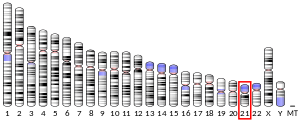CYYR1
| CYYR1 | |||||||||||||||||||||||||
|---|---|---|---|---|---|---|---|---|---|---|---|---|---|---|---|---|---|---|---|---|---|---|---|---|---|
| Identifiers | |||||||||||||||||||||||||
| Aliases | CYYR1, C21orf95, cysteine and tyrosine rich 1 | ||||||||||||||||||||||||
| External IDs | MGI: 2152187 HomoloGene: 14191 GeneCards: CYYR1 | ||||||||||||||||||||||||
| |||||||||||||||||||||||||
| |||||||||||||||||||||||||
| |||||||||||||||||||||||||
| |||||||||||||||||||||||||
| Orthologs | |||||||||||||||||||||||||
| Species | Human | Mouse | |||||||||||||||||||||||
| Entrez | |||||||||||||||||||||||||
| Ensembl | |||||||||||||||||||||||||
| UniProt | |||||||||||||||||||||||||
| RefSeq (mRNA) | |||||||||||||||||||||||||
| RefSeq (protein) | |||||||||||||||||||||||||
| Location (UCSC) | Chr 21: 26.47 – 26.57 Mb | Chr 16: 85.42 – 85.55 Mb | |||||||||||||||||||||||
| PubMed search | [3] | [4] | |||||||||||||||||||||||
| Wikidata | |||||||||||||||||||||||||
| |||||||||||||||||||||||||
Cysteine and tyrosine-rich protein 1 is a protein that in humans is encoded by the CYYR1 gene[5][6][7] and is located on chromosome 21, location 21q21.2. This protein has a function that is not presently understood.
Protein
The product of the gene is a single pass type 1 transmembrane protein with four exons and a very large intron of 85.8 kb and coding for a protein containing 154 amino acids.[8] The most prominent feature identified in the protein is a central, unique cysteine and tyrosine-rich protein domain, on portion of the protein which is located inside the cell. This domain is found to be strongly conserved from lower vertebrates (fishes) to humans but is absent in bacteria and invertebrates.[6]
Properties and Domains
Bioinformatic analysis predicted the following properties for CYYR1:
- Molecular Weight = 16.6kdal
- Isoelectric Point = 8.28
The amino acid sequence is 153 amino acids long and contains 3 domains.[9]
1 MDAPRLPVRP GVLLPKLVLL FVYADDCLAQ CGKDCKSYCC DGTTPYCCSY 51 YAYIGNILSG TAIAGIVFGI VFIMGVIAGI AICICMCMKN HRATRVGILR 101 TTHINTVSSY PGPPPYGHDH EMEYCDLPPP YSPTPQGPAQ RSPPPPYPGN 151 ARK
Using bioinformatic tools the following domains were determined:
- Signal Peptide[8] - Position 1-29
- Transmembrane Domain[8] - Position 62-82
- Poly-Proline Domain[8] - Position 144-149
Orthologs
Multiple sequence alignments were done with orthologs of the CYYR1 gene and they show that the protein sequence is highly conserved throughout all vertebrates.
| Species | Accession # | Identity |
|---|---|---|
| Pan troglodytes | XP_001158941.1 | 99.2%[10] |
| Macaca mulatta | XP_001104127.1 | 95.5%[10] |
| Mus musculus | NP_659102.1 | 88.2%[10] |
| Xenopus laevis | NP_001088967.1 | 74.3%[10] |
| Danio rerio | NP_998047.1 | 60.4%[10] |
There are no known or predicted paralogs in homo sapiens.
Interactions
CYYR1 has been shown to increase glutathione level in yeast cells when complementing a defect in GSH uptake in yeast cells that lack Hgt1p, the primary yeast GSH uptake transporter.[11] However, the CYYR1 gene is not naturally found in yeast, so function of CYYR1 is still unknown.
References
- 1 2 3 GRCh38: Ensembl release 89: ENSG00000166265 - Ensembl, May 2017
- 1 2 3 GRCm38: Ensembl release 89: ENSMUSG00000041134 - Ensembl, May 2017
- ↑ "Human PubMed Reference:".
- ↑ "Mouse PubMed Reference:".
- ↑ Reymond A, Camargo AA, Deutsch S, Stevenson BJ, Parmigiani RB, Ucla C, Bettoni F, Rossier C, Lyle R, Guipponi M, de Souza S, Iseli C, Jongeneel CV, Bucher P, Simpson AJ, Antonarakis SE (May 2002). "Nineteen additional unpredicted transcripts from human chromosome 21". Genomics. 79 (6): 824–32. doi:10.1006/geno.2002.6781. PMID 12036297.
- 1 2 Vitale L, Casadei R, Canaider S, Lenzi L, Strippoli P, D'Addabbo P, Giannone S, Carinci P, Zannotti M (Jun 2002). "Cysteine and tyrosine-rich 1 (CYYR1), a novel unpredicted gene on human chromosome 21 (21q21.2), encodes a cysteine and tyrosine-rich protein and defines a new family of highly conserved vertebrate-specific genes". Gene. 290 (1–2): 141–51. doi:10.1016/S0378-1119(02)00550-4. PMID 12062809.
- ↑ "Entrez Gene: CYYR1 cysteine/tyrosine-rich 1".
- 1 2 3 4 "Cysteine and tyrosine-rich protein 1 precursor - Homo sapiens".
- ↑ SDSC Biology Workbench 2.0
- 1 2 3 4 5 "Cysteine/tyrosine-rich 1 - Homo sapiens".
- ↑ Shi S, Notenboom S, Dumont ME, Ballatori N (Jan 2010). "Identification of Human Gene Products Containing Pro-Pro-x-Tyr (PY) Motifs that Enhance Glutathione and Endocytotic Marker Uptake in Yeast". Cell Physiol Biochem. 25 (2–3): 293–306. doi:10.1159/000276570. PMC 3030462. PMID 20110690.
Further reading
- Maruyama K, Sugano S (1994). "Oligo-capping: a simple method to replace the cap structure of eukaryotic mRNAs with oligoribonucleotides". Gene. 138 (1–2): 171–4. doi:10.1016/0378-1119(94)90802-8. PMID 8125298.
- Suzuki Y, Yoshitomo-Nakagawa K, Maruyama K, et al. (1997). "Construction and characterization of a full length-enriched and a 5'-end-enriched cDNA library". Gene. 200 (1–2): 149–56. doi:10.1016/S0378-1119(97)00411-3. PMID 9373149.
- Hattori M, Fujiyama A, Taylor TD, et al. (2000). "The DNA sequence of human chromosome 21". Nature. 405 (6784): 311–9. doi:10.1038/35012518. PMID 10830953.
- Strausberg RL, Feingold EA, Grouse LH, et al. (2003). "Generation and initial analysis of more than 15,000 full-length human and mouse cDNA sequences". Proc. Natl. Acad. Sci. U.S.A. 99 (26): 16899–903. doi:10.1073/pnas.242603899. PMC 139241. PMID 12477932.
- Ota T, Suzuki Y, Nishikawa T, et al. (2004). "Complete sequencing and characterization of 21,243 full-length human cDNAs". Nat. Genet. 36 (1): 40–5. doi:10.1038/ng1285. PMID 14702039.
- Gerhard DS, Wagner L, Feingold EA, et al. (2004). "The Status, Quality, and Expansion of the NIH Full-Length cDNA Project: The Mammalian Gene Collection (MGC)". Genome Res. 14 (10B): 2121–7. doi:10.1101/gr.2596504. PMC 528928. PMID 15489334.
- Vitale L, Frabetti F, Huntsman SA, et al. (2007). "Sequence, "subtle" alternative splicing and expression of the CYYR1 (cysteine/tyrosine-rich 1) mRNA in human neuroendocrine tumors". BMC Cancer. 7: 66. doi:10.1186/1471-2407-7-66. PMC 1863428. PMID 17442112.




